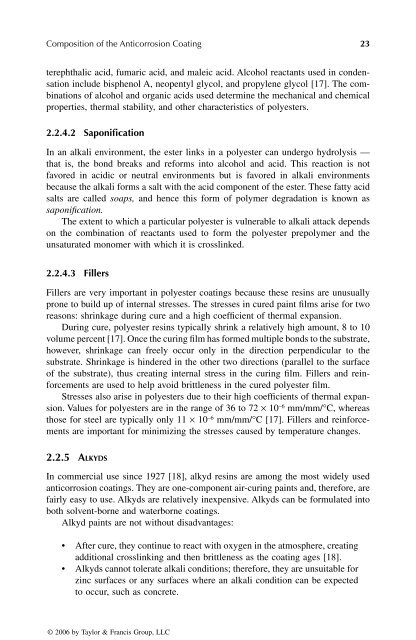© 2006 by Taylor & Francis Group, LLC
© 2006 by Taylor & Francis Group, LLC
© 2006 by Taylor & Francis Group, LLC
Create successful ePaper yourself
Turn your PDF publications into a flip-book with our unique Google optimized e-Paper software.
Composition of the Anticorrosion Coating 23<br />
terephthalic acid, fumaric acid, and maleic acid. Alcohol reactants used in condensation<br />
include bisphenol A, neopentyl glycol, and propylene glycol [17]. The combinations<br />
of alcohol and organic acids used determine the mechanical and chemical<br />
properties, thermal stability, and other characteristics of polyesters.<br />
2.2.4.2 Saponification<br />
In an alkali environment, the ester links in a polyester can undergo hydrolysis —<br />
that is, the bond breaks and reforms into alcohol and acid. This reaction is not<br />
favored in acidic or neutral environments but is favored in alkali environments<br />
because the alkali forms a salt with the acid component of the ester. These fatty acid<br />
salts are called soaps, and hence this form of polymer degradation is known as<br />
saponification.<br />
The extent to which a particular polyester is vulnerable to alkali attack depends<br />
on the combination of reactants used to form the polyester prepolymer and the<br />
unsaturated monomer with which it is crosslinked.<br />
2.2.4.3 Fillers<br />
Fillers are very important in polyester coatings because these resins are unusually<br />
prone to build up of internal stresses. The stresses in cured paint films arise for two<br />
reasons: shrinkage during cure and a high coefficient of thermal expansion.<br />
During cure, polyester resins typically shrink a relatively high amount, 8 to 10<br />
volume percent [17]. Once the curing film has formed multiple bonds to the substrate,<br />
however, shrinkage can freely occur only in the direction perpendicular to the<br />
substrate. Shrinkage is hindered in the other two directions (parallel to the surface<br />
of the substrate), thus creating internal stress in the curing film. Fillers and reinforcements<br />
are used to help avoid brittleness in the cured polyester film.<br />
Stresses also arise in polyesters due to their high coefficients of thermal expansion.<br />
Values for polyesters are in the range of 36 to 72 × 10 –6 mm/mm/°C, whereas<br />
those for steel are typically only 11 × 10 –6 mm/mm/°C [17]. Fillers and reinforcements<br />
are important for minimizing the stresses caused <strong>by</strong> temperature changes.<br />
2.2.5 ALKYDS<br />
In commercial use since 1927 [18], alkyd resins are among the most widely used<br />
anticorrosion coatings. They are one-component air-curing paints and, therefore, are<br />
fairly easy to use. Alkyds are relatively inexpensive. Alkyds can be formulated into<br />
both solvent-borne and waterborne coatings.<br />
Alkyd paints are not without disadvantages:<br />
• After cure, they continue to react with oxygen in the atmosphere, creating<br />
additional crosslinking and then brittleness as the coating ages [18].<br />
• Alkyds cannot tolerate alkali conditions; therefore, they are unsuitable for<br />
zinc surfaces or any surfaces where an alkali condition can be expected<br />
to occur, such as concrete.<br />
<strong>©</strong> <strong>2006</strong> <strong>by</strong> <strong>Taylor</strong> & <strong>Francis</strong> <strong>Group</strong>, <strong>LLC</strong>
















